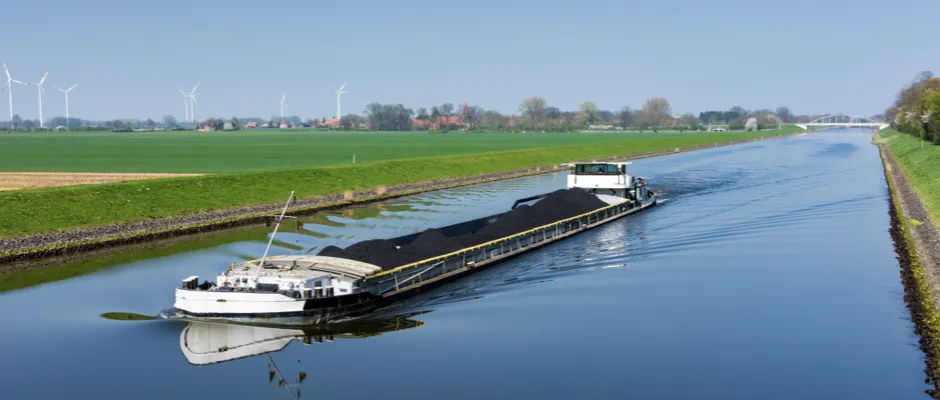GTL in Inland Shipping: Cleaner Diesel Without Engine Modifications
Author: Jeroen Berger • Publication date:
GTL (Gas-to-Liquid) is a synthetic diesel fuel that can be used in conventional inland shipping engines without any technical modifications. It is produced from natural gas through the Fischer-Tropsch process, a chemical conversion in which methane is transformed under high pressure and temperature into liquid paraffinic hydrocarbons. GTL is odorless, sulfur-free (less than 5 ppm), low in aromatics (<1%), and fully miscible with conventional fossil diesel.
Thanks to its high cetane number (75–80) and low aromatic content, GTL combusts more quietly and cleanly than conventional diesel. In practice, this results in reduced soot formation, noticeably less odor, and up to 4 decibels less engine noise at partial load. Since GTL is compatible with existing engine configurations, no adjustments are needed to injection timing, compression ratio, or fuel distribution.
For inland vessels operating in emission-sensitive zones such as urban waterways, inland ports, and transshipment areas, GTL offers an immediately applicable solution. The fuel meets the European standard EN 15940:2016 for paraffinic diesel from synthesis and is legally permitted in existing diesel engines, provided the engine manufacturer explicitly allows its use.
This article analyzes the chemical properties, emission performance, and operational applicability of GTL in inland shipping. The fuel is positioned within the broader context of the energy transition, where retrofit, aftertreatment, and alternative propulsion are not always (immediately) feasible.
Cleaner Combustion and Reduced Engine Noise
GTL’s chemical purity yields immediate on-board benefits. Due to its near-zero sulfur and aromatic content, the combustion process produces significantly less soot and minimizes combustion residues. As a result, injectors, piston rings, and exhaust valves remain cleaner, exhaust channels are less prone to fouling, and engine oil discolors more slowly. This indicates that harmful combustion residues barely reach the crankcase.
The high cetane number ensures quick and uniform ignition of the fuel. This leads to smoother engine operation with reduced vibrations and less diesel knock. In practice, this results in significantly lower engine noise during maneuvering or idling, especially in quiet or densely built-up waterways.
However, GTL requires additional attention in older engines that have long operated on aromatic-rich diesel. The cleaner composition can affect certain rubber components such as hoses, seals, or O-rings. When in doubt, these should be inspected and, if necessary, replaced with GTL-resistant materials such as fluoroelastomer (FKM) or hydrogenated nitrile rubber (HNBR).
Lower Emissions Without Exhaust System Modifications
Independent field tests show that GTL significantly reduces the emission of harmful substances, without the use of particulate filters or SCR catalysts. Depending on engine type and load, reductions have been measured of up to 50% less particulate matter (PM), 5–30% less nitrogen oxides (NOx), and 30–50% less carbon monoxide (CO) and unburned hydrocarbons (HC). These measurements were performed at representative partial loads under conditions reflecting typical operation.
These emission reductions are directly attributable to GTL’s chemical composition. As the fuel contains virtually no sulfur (<5 ppm) and minimal aromatics (<1%), combustion is significantly cleaner. This leads to visibly clearer exhaust gases, negligible sulfur oxide (SOx) emissions, and substantially less odor, particularly during idling, mooring, or maneuvering in sensitive locations such as city centers, ports, and transshipment sites.
GTL thus contributes directly to cleaner air around the vessel. However, it remains a fossil fuel and does not reduce total CO2 emissions across the entire lifecycle (“well-to-wake”). Consequently, GTL primarily improves local air quality but does not support long-term climate goals.
Reliable Performance Without System Adjustments – Even in Cold Weather
GTL remains liquid at temperatures as low as –20 °C (CFPP < –20 °C), ensuring reliable engine startup even during frost conditions. This makes it suitable for a wide range of vessel types, from year-round cargo vessels to seasonal passenger ships, pontoons, or floating equipment operating in varying weather conditions.
When switching to GTL for the first time, it is important to pay extra attention to the fuel system. GTL may loosen existing deposits in tanks and pipelines, especially in engines that have run on conventional diesel for extended periods. Inspecting fuel filters during the first 50 operating hours is essential. Replacing filters preventively can help avoid clogging and unplanned downtime.
A major advantage of GTL is its full compatibility with conventional diesel (EN 590). GTL can be blended or used as a full replacement without the need for tank cleaning, system modifications, or engine recalibration. This makes the fuel easy to apply, both on individual vessels and fleet-wide, regardless of bunkering schedules or fuel inventories.
Costs, Availability, and Policy Framework
Although GTL is technically reliable, economic feasibility remains a concern. The Fischer-Tropsch production process is energy-intensive, making GTL more expensive than conventional diesel. In addition, GTL yields slightly less energy per liter, resulting in 5–10% higher fuel consumption. This leads to a shorter operational range per bunkering, especially relevant for vessels with limited tank capacity or long distances between bunkering stations.
Smooth operations therefore require careful planning of routes, inventories, and bunkering intervals. This is particularly important given GTL’s limited availability, currently restricted to locations such as Zwijndrecht, Heijningen, and the Rotterdam port area. Fleet-wide adoption may require additional storage facilities on board or on shore.
GTL complies with the European fuel standard EN 15940 and is legally permitted in inland shipping, provided the engine is suitable for paraffinic diesel. This means existing engines can run on GTL without technical modifications.
Nevertheless, there are policy-related limitations. As GTL is derived from fossil sources, it is not covered by Directive (EU) 2018/2001 (RED II). As a result, it does not qualify for Renewable Fuel Units (HBE’s) in the Netherlands, nor does it offer fiscal or certification advantages.
However, GTL is recognized as an interim solution within programs such as the Green Deal for Maritime Shipping, Inland Shipping, and Ports. A key requirement is that its use aligns with a transition strategy toward truly sustainable propulsion such as HVO, hydrogen, or ammonia. Only when GTL is integrated into a strategic roadmap toward zero-emission technology can it be considered a legitimate transitional option within the energy transition.
Field Experience: Reliable and Noticeably Cleaner
Field tests confirm that GTL performs reliably in existing inland shipping engines without requiring technical adjustments. In real world test programs, including those conducted by Shell, substantial emission reductions were measured under realistic operating conditions: up to 59% less particulate matter (PM) and 38% less nitrogen oxides (NOx), without exhaust aftertreatment. These results demonstrate that GTL has a measurable local impact even in conventional engines.
A concrete example is Danser Group’s ChangeTL pilot in 2019, which tested a blend of 80% GTL and 20% biofuel. The blend performed stably, provided that additives for lubrication and oxidation stability were used. However, some older engines were sensitive to material changes, requiring the replacement of seals during the transition from aromatic-rich diesel to paraffinic GTL.
Demonstrations in urban waterways also confirmed that GTL not only ensures technical reliability but also contributes to better working conditions on board. Less smoke, odor, and noise create a more pleasant working environment and enhance the social acceptability of inland shipping operations, an increasingly important factor in permit procedures and policy decisions.
GTL as a Transitional Solution in the Energy Transition
GTL is not a final solution but a transitional measure. Only when integrated into a strategy toward zero-emission propulsion does it maintain a justified role within long-term climate-neutral shipping plans.
Alternatives such as HVO (Hydrotreated Vegetable Oil) offer genuine well to wake CO2 reductions, typically between 40% and 90%, depending on the feedstock and certification method. HVO is recognized as renewable energy under Directive (EU) 2018/2001 and counts toward national renewable energy targets in transport.
By contrast, GTL only reduces local emissions and has no effect on total CO2 output from source to combustion. As such, GTL remains suitable primarily as a temporary solution when transitioning to HVO or other zero-emission technologies is not yet operationally or financially feasible.


